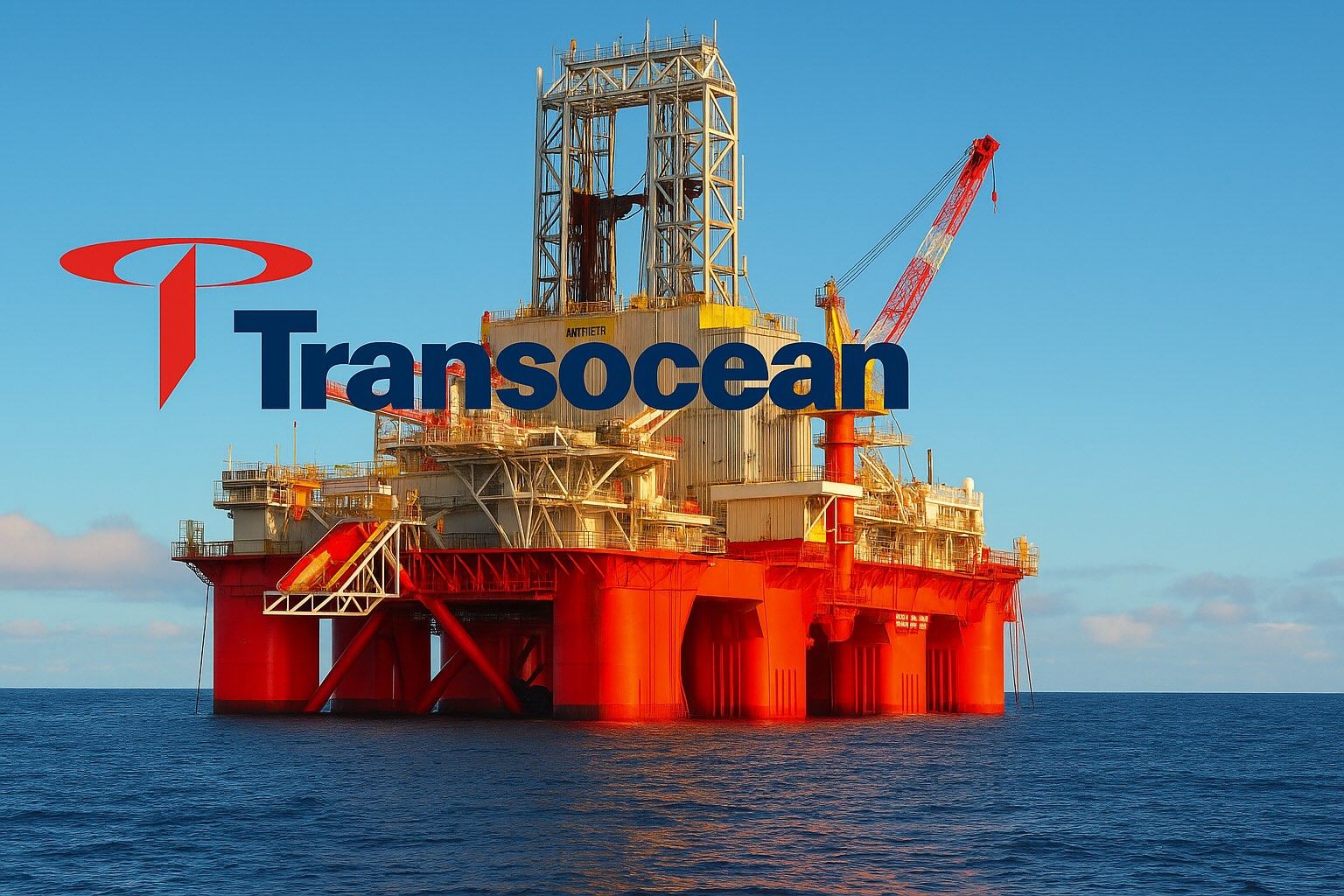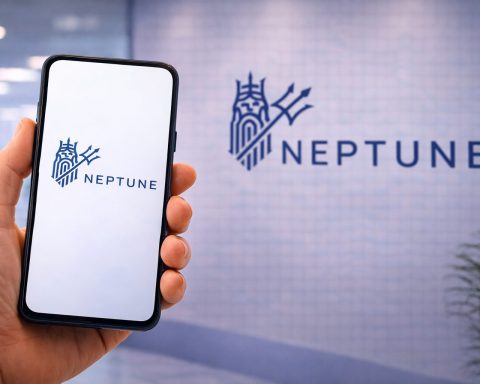Key Facts (as of Oct. 20, 2025)
- Stock Price & Momentum: Transocean Ltd. (NYSE: RIG) shares trade around the mid-$3 range, recently closing near $3.31 after a volatile month. The stock rebounded about 5–6% last week, recovering from late-September lows around $3.14 [1].
- Insider Confidence: A major shareholder, Frederik W. Mohn (via his investment firm Perestroika Ltd.), purchased 4 million shares for $12.2 million during the recent equity offering – a bold insider buy that boosted market confidence [2] [3]. This raised Mohn’s stake above 10%, signaling strong insider conviction in Transocean’s rebound.
- New Contracts & Backlog: Transocean secured $243 million in new drilling contracts for two ultra-deepwater rigs, underscoring rising demand for offshore oil projects [4]. The company’s order backlog stood at $7.2 billion as of Q2 2025, reflecting improved industry activity [5].
- Debt Reduction Moves: In late September, Transocean raised $381 million via a public stock offering of 125 million shares at $3.05 (≈13% dilution) [6]. Proceeds are earmarked to pay down high-interest debt, notably part of its 8% senior notes due 2027 [7]. The company also issued $500 million in new notes and launched a cash tender offer to refinance nearer-term liabilities [8]. These steps aim to cut interest costs and strengthen the balance sheet.
- Fleet Overhaul: Transocean is streamlining its rig fleet – selling or scrapping five older “stacked” rigs – which will incur a one-time $1.9 billion non-cash impairment in Q3 2025 [9]. This write-down, though painful on paper, removes idle assets and allows focus on higher-spec drillships, positioning the company for better long-term profitability.
- Analyst Outlook: Wall Street’s 12-month consensus price target is around $4.20–$4.30 per share, ~25–30% above current levels [10]. Price targets range from about $2.80 (bearish) to $5.50 (bullish) [11]. Bank of America recently raised its target to $3 (from $2.50) but maintained an “Underperform” rating – reflecting cautious optimism despite the stock’s recent strides [12]. Overall analyst sentiment is mixed “Hold,” citing Transocean’s heavy debt but also improved prospects in a recovering offshore drilling market.
- Market Context: Crude oil prices in October remain relatively soft (WTI ~$56, Brent ~$60) compared to last year [13], which has tempered energy stock performance. However, industry experts note that offshore projects can break even at ~$20–$35 per barrel – far lower than many shale wells – thanks to technology gains [14]. This trend, coupled with rising deepwater investment, is shifting the oil growth story back offshore, benefiting contractors like Transocean.
Transocean Rallies on Insider Buy and New Deals
Transocean’s stock has staged a modest comeback in mid-October after a slew of positive developments reignited investor interest. On October 16, RIG shares jumped over 5% in a single session as the market cheered news of insider buying, fresh contracts, and proactive debt refinancings [15]. The rally was spurred in part by Frederik Wilhelm Mohn – a Transocean board member and scion of a prominent Norwegian oil family – accumulating 4 million shares (about $12.2 million worth) in the recent equity offering [16]. Such a purchase by an existing insider (Mohn’s investment vehicle, Perestroika Ltd.) is “highly unusual and shows strong conviction in RIG stock from a major investor,” according to MarketBeat analysts [17] [18]. This bold vote of confidence helped counter dilution fears and signaled to the market that those closest to the company see significant value at current prices.
At the same time, Transocean revealed it won $243 million in new contracts for two of its ultra-deepwater drillships [19]. These multi-hundred-million-dollar awards not only boost the firm’s revenue backlog but also “signal stronger demand for offshore drilling” going forward [20]. Securing new work at healthy dayrates reinforces that oil companies are investing in major offshore projects again – a key factor for Transocean’s long-term recovery. The company’s backlog, a measure of future revenue from signed drilling contracts, had already climbed to $7.2 billion by mid-2025 [21], and the recent contract wins add to that growing pipeline.
Another catalyst for the stock’s strength was Transocean’s aggressive steps to address its debt. In mid-October the company priced $500 million in new secured notes (via a private offering) and simultaneously launched a cash tender offer to retire some of its nearer-term bonds [22]. These moves come on the heels of the late-September equity raise and are aimed at managing debt maturities and reducing interest costs. By shoring up its liquidity and pushing out debt, Transocean is trying to ensure it can weather any market volatility until higher-margin contracts translate into stronger cash flow. “We also continue to improve our balance sheet and are on track to reduce our debt by over $700 million this year,” CEO Keelan Adamson had stated back in August [23] – and recent actions back up that deleveraging focus.
Wall Street is taking note of these developments. In fact, Bank of America cited Transocean’s strategic maneuvers in raising its price objective on RIG to $3 (from $2.50), while maintaining an underperform rating [24]. BofA’s stance suggests that even skeptics acknowledge Transocean’s improving outlook, though they remain cautious on near-term upside. On October 15, just before these announcements, Transocean’s stock closed around $3.31 [25] – continuing an upward trend as investors assessed the insider buy-in and balance sheet improvements. The recent rally has lifted RIG well off its late-September lows, indicating momentum has swung positive for now, albeit on modest trading volumes.
Dilution Shock: $381 M Share Sale to Tackle Debt
Just a few weeks ago, Transocean’s stock was reeling from a dilution-driven selloff. On September 25, the company surprised the market by upsizing a public share offering to 125 million new shares at $3.05 each, raising roughly $381 million in gross proceeds [26]. This represented a significant ~13% expansion of the share count (or up to ~15% if underwriters exercise an overallotment) [27]. The capital raise – equivalent to about one-tenth of Transocean’s pre-offer market value – was intended to chip away at the company’s hefty debt load, specifically targeting the redemption of a chunk of its 8.00% senior notes due 2027 [28]. Management indicated any leftover cash would go toward general corporate needs, but debt reduction is the clear priority. By paying down high-interest bonds, Transocean can save tens of millions in annual interest expense, easing a notable financial burden [29].
The immediate market reaction was painful: RIG shares tumbled as much as 13–17% in pre-market trading when the equity offer pricing hit the wires [30]. Investors were rattled by the dilution and the steep 11% discount to the prior day’s closing price. Transocean’s stock, which had been trading around $3.60, sank toward the low $3s, touching roughly $3.14 on the news [31]. By Sept. 26, the dust settled with RIG around $3.16 [32] – down sharply, though notably the share price actually finished the full month of September up ~5% overall despite the offer [33]. This resilience was partly due to the aforementioned insider (Perestroika/Mohn) stepping in to purchase a substantial portion of the new shares, indicating to other investors that the dilution might be a long-term gain if it fixes the balance sheet [34] [35]. In the classic trade-off, Transocean chose to endure some near-term EPS dilution in exchange for shoring up its capital structure – a strategy similar to other offshore drilling peers who raised equity this year to deleverage (for example, Borr Drilling’s summer stock sale) [36] [37].
Crucially, Transocean’s decision to raise equity came from a position of improving fundamentals rather than desperation. The company’s Q2 2025 results showed $988 million in revenue – above analyst forecasts [38] – and essentially breakeven adjusted earnings. It also marked a turning point of positive free cash flow generation in 2025 [39]. Transocean boasted a $7.2 billion contract backlog by mid-year and healthier rig utilization, thanks to surging demand for ultra-deepwater projects [40]. With this backdrop, CEO Adamson stressed paying down debt while the offshore cycle gathers steam, saying Transocean was “on track to reduce our debt by over $700 million this year” [41]. In late August the company took another tough-but-necessary step: it moved to divest five aging “stacked” rigs (mostly idle units), essentially opting to scrap them. Industry reports in September confirmed four idle rigs were sold for demolition, illustrating Transocean’s commitment to pruning lower-spec assets from its fleet [42]. The company will take a ~$1.9 billion impairment charge in Q3 related to these disposals [43] – a non-cash hit that will deepen the upcoming quarterly loss, but one that could “right-size” the fleet for higher utilization going forward. By culling older rigs and raising new cash to retire debt, Transocean is attempting a high-stakes balance sheet repair that could set it up for a more sustainable future if executed well.
Forecasts and Sentiment: Cautious Optimism Prevails
Even after the recent bounce, Transocean’s stock remains well below its highs, leaving room for potential upside if the offshore recovery continues. At ~$3.25–$3.30 per share, RIG is trading at only about 70% of its 52-week high ($4.74) and a fraction of its levels from the last oil upcycle [44]. Wall Street analysts, on average, project that the stock will climb from these levels: the consensus 12-month price target is roughly $4.20–$4.30 [45]. If achieved, that would mark about a 25–30% gain from current prices, reflecting expectations that Transocean’s deleveraging and improving contract rates will eventually boost equity value. The most bullish analysts see the stock heading as high as $5+ (topping the recent year’s high), while the most bearish have targets in the upper $2s (below today’s price) [46]. MarketBeat reports that among 10 analysts, the consensus recommendation is a Hold, but notably with a forecasted +30% upside to a ~$4.26 average target [47]. Similarly, FactSet data shows a slightly lower mean target around $3.8 (with some “Overweight” ratings in the mix) [48], suggesting a cautiously positive skew in expectations despite the neutral official ratings.
Recent commentary from market experts underscores this guarded optimism. “Transocean offers a unique opportunity for investors willing to look beyond today’s oil market malaise,” one analyst wrote, arguing that the combination of insider buying, fleet high-grading, and debt reduction “sets a compelling foundation for stronger EPS growth—especially in a rising oil price environment.” [49] The stock currently trades at an extremely low price-to-book ratio (~0.3x) – a steep discount to the broader energy sector’s ~4.5x [50]. This reflects lingering concerns (large debt, recent dilution, still-recovering rig demand), but it also highlights the value proposition if Transocean’s assets and earnings power return to form. In short, many investors see RIG as undervalued relative to its assets and turnaround potential, provided the offshore drilling cycle continues to improve.
Still, risks temper the sentiment. Bank of America’s recent target boost to $3 is accompanied by an Underperform rating [51] – effectively a signal that BofA expects Transocean to lag the broader market. Their cautious stance likely hinges on the company’s high leverage and the execution risk in meeting aggressive debt-cutting goals. Additionally, with a massive impairment looming in Q3 results (scheduled for release on Oct. 29, 2025) and roughly $6.5 billion of total debt still on the books [52], Transocean has little margin for error. The upcoming earnings report will be closely watched for updates on how management is handling interest costs, rig reactivations, and any guidance for 2026. Investor sentiment appears to be in “prove it” mode – encouraged by the recent insider buying and contract wins, but waiting to see concrete evidence of improved financial performance in the quarters ahead. As one market observer noted, the stock’s volatility in October (swinging down ~8% one week and up 10% the next) reflects traders “digesting a flood of news and trying to gauge if this is the start of a genuine comeback or just a short-term bounce.” For now, cautious optimism prevails, with the stock’s modest climb indicating the street is giving Transocean a tentative nod – albeit with an eye on oil prices and earnings for confirmation.
Oil Market Trends: Offshore Drilling Back in the Spotlight
Transocean’s fortunes are inextricably tied to the global oil and gas cycle – and right now, the broader industry backdrop is mixed but improving for offshore contractors. On the one hand, crude oil prices in late 2025 have been underwhelming: U.S. WTI oil has hovered in the mid-$50s per barrel [53], and Brent in the low $60s, amid concerns about sluggish demand in major economies and ample supply. These “cyclically low” prices [54] have kept many energy investors on the sidelines and pressured the share prices of oilfield service firms. However, a deeper look reveals a nascent shift that could favor companies like Transocean. U.S. shale production growth is slowing after a decade of dominance, as the most prolific land basins mature and capital spending in onshore drilling tightens. In contrast, offshore (particularly deepwater) projects are gaining momentum as technology lowers their cost and governments offer support.
Industry experts point out that technological advances now allow drilling in high-pressure, ultra-deepwater reservoirs at much lower cost. “Offshore production will play an increasingly larger role in filling global energy demand,” asserted Talos Energy’s CEO, noting that some new deepwater developments can break even at oil prices as low as $20–$35 per barrel [55] [56]. That is a remarkable figure – well below typical shale breakevens – and it means many offshore projects remain economically viable even with oil around $55–$60. For instance, Talos affirmed its Gulf of Mexico drilling plans for H2 2025 are still attractive at ~$35 average oil prices [57]. This resilience is driving a comeback in offshore investment: the U.S. government’s EIA projects Gulf of Mexico oil output will rise by ~100,000 barrels/day in 2025 and keep climbing into 2026 [58], reversing declines from earlier in the decade. Likewise, globally, deepwater exploration is accelerating from Brazil to West Africa to the North Sea. Such trends bode well for Transocean, which specializes in ultra-deepwater and harsh-environment drilling and operates a fleet of 27 mobile offshore rigs (20 ultra-deepwater drillships/semi-submersibles and 7 harsh-environment floaters) [59]. As one of the world’s largest offshore drilling contractors, Transocean stands to benefit disproportionately when oil majors green-light more deepwater projects.
There are already signs of this offshore upswing in Transocean’s recent contract log. During Q2, the company landed several notable charters – including multi-year gigs in Norway at dayrates near $400,000 per day and in Australia at over $500,000 per day for its high-spec drillships [60]. Such robust pricing, far above the downturn lows, indicates drilling rates have recovered alongside oil companies’ renewed appetite for exploration. Overall global rig utilization has been ticking upward, and while the U.S. total rig count has fluctuated (recently dipping slightly) as shale activity cools [61], the offshore segment is clearly on an upswing. “We believe offshore production will continue to support record [oil] levels…with growth in offshore increasingly supporting supply,” Chevron noted in a recent outlook, highlighting that its own Gulf of Mexico output is set to jump 50% by 2026 [62] [63]. This broader context of an offshore resurgence provides a tailwind for Transocean’s business, even if oil prices remain moderate.
Investors in RIG will be watching these macro factors closely. If oil prices strengthen later in 2025 or in 2026 – for example, due to OPEC+ tightening or a rebound in global demand – it could further improve Transocean’s prospects by spurring additional contracts and improving cash flows. Conversely, if oil stays soft or falls further, the road to recovery could be slower, putting pressure on Transocean’s liquidity despite its recent fundraising. In the near term, the company’s strategy is clear: bet on the offshore cycle by cleaning up the balance sheet now, so that it can fully capitalize on the multi-year uptrend in deepwater drilling. It’s a plan that entails short-term pain (dilution, impairments) for long-term gain. The next few weeks will bring critical updates – including Q3 earnings (with that large impairment) and possibly new guidance – which should shed more light on Transocean’s trajectory. In the meantime, the stock’s inclusion in Google News and Discover feeds suggests growing public interest in this turnaround story. For investors, Transocean represents a classic high-risk, high-reward scenario: a beaten-down oilfield stock rallying on fresh catalysts, hoping to ride a sea change in the offshore industry’s fortunes. [64] [65]
Sources: Transocean/Deepwater investor releases; TechStock² (TS2.tech) analysis [66] [67]; Investing.com [68]; MarketBeat [69] [70]; Reuters [71] [72]; Yahoo Finance/Simply Wall St.; Bank of America via MarketScreener [73].
References
1. ts2.tech, 2. ts2.tech, 3. www.marketbeat.com, 4. ts2.tech, 5. ts2.tech, 6. ts2.tech, 7. ts2.tech, 8. ts2.tech, 9. www.investing.com, 10. www.marketbeat.com, 11. www.marketbeat.com, 12. ts2.tech, 13. www.investing.com, 14. www.reuters.com, 15. ts2.tech, 16. ts2.tech, 17. www.marketbeat.com, 18. www.marketbeat.com, 19. ts2.tech, 20. ts2.tech, 21. ts2.tech, 22. ts2.tech, 23. ts2.tech, 24. ts2.tech, 25. ts2.tech, 26. ts2.tech, 27. ts2.tech, 28. ts2.tech, 29. ts2.tech, 30. ts2.tech, 31. ts2.tech, 32. ts2.tech, 33. www.marketbeat.com, 34. www.marketbeat.com, 35. www.marketbeat.com, 36. ts2.tech, 37. ts2.tech, 38. www.investing.com, 39. ts2.tech, 40. ts2.tech, 41. ts2.tech, 42. ts2.tech, 43. www.investing.com, 44. www.marketbeat.com, 45. www.marketbeat.com, 46. www.marketbeat.com, 47. www.marketbeat.com, 48. news.futunn.com, 49. www.marketbeat.com, 50. www.marketbeat.com, 51. ts2.tech, 52. www.investing.com, 53. www.investing.com, 54. www.marketbeat.com, 55. www.reuters.com, 56. www.reuters.com, 57. www.reuters.com, 58. www.reuters.com, 59. www.investing.com, 60. ts2.tech, 61. energynewsbeat.co, 62. www.reuters.com, 63. www.reuters.com, 64. www.marketbeat.com, 65. ts2.tech, 66. ts2.tech, 67. ts2.tech, 68. www.investing.com, 69. www.marketbeat.com, 70. www.marketbeat.com, 71. www.reuters.com, 72. www.reuters.com, 73. ts2.tech










